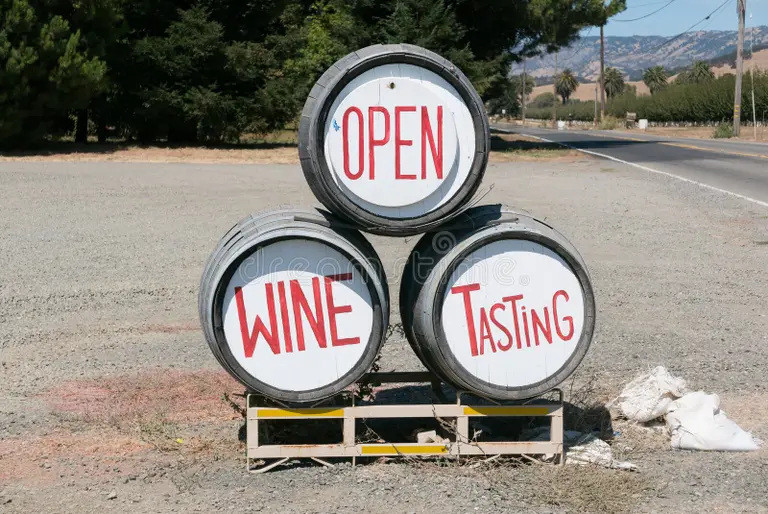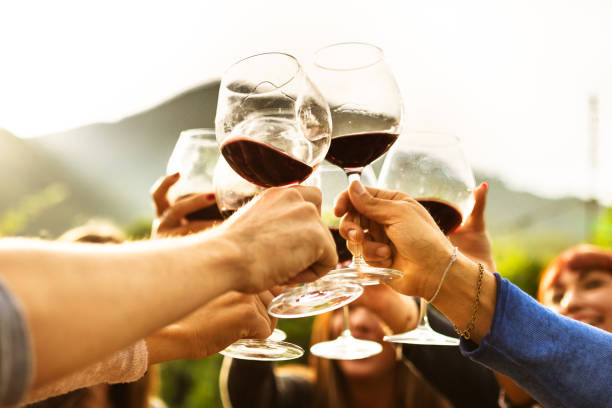Introduction to Wine Tasting at a Winery

Definition of wine tasting: Wine tasting is an artful practice that involves experiencing and evaluating the flavors, aromas, and nuances of different wines. It is a sensory journey that allows wine enthusiasts to explore the complexities and characteristics of various varietals.
Importance of wine tasting at a winery: Wine tastings are more than just opportunities for indulging in delicious libations. They serve as educational experiences that enhance our understanding and appreciation of the intricate world of winemaking.
At a winery, tastings provide visitors with a unique chance to sample wines directly from the source, gaining insights into their production processes, terroir influences, and aging techniques. When it comes to visiting a winery, embarking on a wine tasting adventure unveils layers of sensory pleasure.
Whether you’re a novice or an experienced oenophile, these delightful gatherings allow you to refine your palate while immersing yourself in the enchanting realm of viniculture. Wine tastings offer an array of benefits beyond simply savoring fermented grape juice.
By engaging in this exquisite activity, one gains access to behind-the-scenes knowledge about each wine’s origins, cultivation methods employed by skilled vintners, and even the artistry involved in perfecting flavor profiles. Moreover, indulging in this sensory exploration under the guidance of knowledgeable sommeliers adds depth and meaning to every sip.
When we partake in wine tastings at wineries, we embark on a fascinating voyage that not only pleases our palates but also enriches our understanding and appreciation for this ancient craft. So join us as we delve deeper into how these tastings are conducted—unveiling secrets hidden within every bottle poured with care by passionate vintners.
Setting the Stage for Wine Tasting
Welcoming guests to the winery
When guests arrive at a winery for a wine tasting experience, they are greeted with warmth and hospitality. The winery staff understands the importance of making visitors feel welcome and comfortable from the moment they step through the door.
A friendly smile, a genuine greeting, and perhaps even a glass of sparkling wine are all part of this delightful experience. The staff at the winery takes pride in creating a warm and inviting atmosphere that sets the tone for an enjoyable wine tasting adventure.
They may provide an introduction to the history of the winery, sharing fascinating details about its vineyards, production techniques, and unique characteristics. This not only enhances guests’ understanding but also creates a sense of connection to the winemaking process.
Creating an ambiance conducive to wine tasting
To truly appreciate and savor wine, it is important to create an ambiance that complements this sensory journey. Wineries go above and beyond to ensure that every detail contributes to an environment that enhances the flavors and aromas of their wines.
Soft lighting illuminates beautifully designed tasting rooms adorned with elegant tables where crystal-clear glasses await each guest. The décor is often inspired by vineyards or rustic elements that evoke a sense of natural beauty.
Comfortable seating arrangements invite visitors to relax as they embark on their tasting experience. Subtle background music fills the air, carefully chosen to complement rather than overpower conversation.
The temperature in the room is carefully controlled, ensuring wines are served at their optimal temperature for maximum enjoyment. All these elements work together harmoniously to create an ambiance that awakens all senses and allows guests to fully immerse themselves in every sip of wine.
When it comes to setting the stage for a memorable wine tasting at a winery, welcoming guests with open arms and creating an ambiance that caters to their unique sensory experience is of utmost importance. These small but significant details contribute to an atmosphere where every aspect of wine tasting is appreciated, from the first pour to the final sip.
The Role of a Sommelier or Wine Expert
When you walk into a winery for a wine tasting, you might come across a suave and sophisticated individual, impeccably dressed, who exudes an air of confidence and knowledge. This person is none other than the sommelier or wine expert.

The role of a sommelier is crucial in ensuring that your wine tasting experience is not only enjoyable but also educational. These wine connoisseurs have spent years studying and mastering the art of wines, from their production to their sensory evaluation.
A sommelier is essentially your guide through the intricacies of wine tasting. They possess an extensive understanding of different grape varieties, vineyards, and winemaking techniques.
Their expertise allows them to navigate the vast world of wines effortlessly, helping guests discover new flavors and appreciate the nuances within each glass. From discussing soil conditions that influence grape growth to unraveling the mysteries behind fermentation and aging processes, they provide valuable insights into every step involved in crafting exceptional wines.
Guiding Guests Through the Wine Tasting Experience
Once you are introduced to your friendly neighborhood sommelier at the winery, prepare yourself for an enlightening journey through the world of wines. These experts are skilled in creating an engaging and informative atmosphere that enhances your tasting experience.
They begin by explaining how to properly hold a wine glass – yes, there’s a technique! By gripping it by the stem rather than cupping it with your hand, you ensure that you don’t inadvertently alter its temperature with body heat.
As you embark on this sensory adventure under their guidance, sommeliers encourage guests to engage all their senses to fully appreciate each varietal’s characteristics. They provide detailed descriptions regarding color variations in different wines while encouraging visual assessment by observing hues ranging from ruby reds to pale yellows.
They then move on to the aromas, urging guests to take a moment to sniff and identify the multitude of scents that await them. From fruity notes of blackberries and citrus to earthy undertones of oak and leather, they help unravel the olfactory complexity within each glass.
It’s time to taste! With their expert guidance, sommeliers encourage you to take small sips, allowing the wine to coat your palate completely.
They explain how different flavors unfold on your tongue – from bright acidity that dances across your taste buds to silky tannins that provide structure and depth. Throughout this process, sommeliers are ready with their wealth of knowledge, answering questions and offering recommendations based on individual preferences.
The presence of a sommelier during a winery visit elevates the tasting experience from merely sipping wine to understanding its intricate nuances. Their expertise ensures that you leave not only with a newfound appreciation for wine but also with valuable knowledge that enriches future wine encounters.
Evaluating the Appearance of the Wine
When it comes to wine tasting, the first impression is often made by the wine’s appearance. Aesthetics play a significant role in our perception of taste, and evaluating the visual aspects can provide valuable insights into the wine’s quality.
Take a moment to examine the color, clarity, and viscosity of the wine in your glass. Observe its hue, whether it leans towards ruby red for red wines or golden yellow for whites.
Notice if there are any variations or gradients within that color spectrum, as these subtle differences can indicate different stages of grape ripeness or winemaking techniques. Next, give your glass a gentle swirl and observe the “legs” that form on its sides.
These legs, also known as tears or church windows, are created by glycerol running down the side of the glass after swirling. They can provide clues about a wine’s alcohol content and body.
Thicker legs may suggest higher alcohol levels or more full-bodied wines, while thinner legs could indicate lighter styles. Remember that wine tasting is a multi-sensory experience; even before taking your first sip, you can gather valuable information about what lies ahead.
Assessing Aroma and Bouquet
Once you have examined the appearance of your wine with care and curiosity, it’s time to engage your olfactory senses to assess its aroma and bouquet—a critical step in any comprehensive wine tasting journey. To fully appreciate a wine’s aromatic profile, gently swirl your glass again to release its scents into an invisible cloud waiting above.
Bring your nose close to the rim of your glass without touching it—a moment akin to meeting someone for an intimate conversation—and inhale deeply. Take note of any identifiable aromas such as ripe berries in red wines or citrus blossoms in whites.
Try to unravel layers within those initial impressions—perhaps detecting notes of vanilla or hints of floral elegance. The intensity and complexity of the aromas can vary greatly, providing insight into the grape variety, winemaking techniques, and even the aging process.
Analyzing Taste and Flavor Profile
After appreciating the visual beauty and aromatic allure of a wine, it is finally time to savor its flavors on your palate. Take a small sip and let it linger in your mouth for a few moments.
Pay attention to how different taste elements manifest themselves—whether it’s the tartness of acidity that dances on your tongue or the gentle sweetness that caresses your palate. Notice any tannins in red wines, which can present as a subtle dryness or grip in your mouth.
As you continue to explore, try to identify specific flavors within the wine. Is it bursting with juicy blackberries or offering delicate hints of apricot?
Consider how these flavors interact with other components such as acidity, sweetness, or even bitterness. This analysis will not only enhance your understanding of the wine but also guide you towards suitable food pairings that can elevate both dining and drinking experiences.
Exploring Different Types of Wines
Red wines
In this section, we delve into the captivating realm of red wines—a category known for its diverse range of styles and expressions. We discuss popular red varietals such as Cabernet Sauvignon and Pinot Noir—each possessing distinct characteristics that captivate wine enthusiasts worldwide. From bold tannins to luscious fruitiness, we explore their unique flavor profiles while offering suggestions for food pairings that complement their personalities perfectly.
White wines
We now turn our attention to white wines—a refreshing alternative that delivers its own delightful array of sensory experiences. Delve into popular white varietals like Chardonnay and Sauvignon Blanc—each offering a spectrum of flavors, from crisp citrus to creamy vanilla.
We explore their distinctive characteristics and discuss optimal serving temperatures that will maximize your enjoyment. Additionally, we provide helpful insights into food pairings that enhance the subtleties of these elegant wines.
Rosé wines
Our exploration wouldn’t be complete without embracing the enchanting world of rosé wines—the epitome of elegance and sophistication. Understanding the unique production methods behind rosés, such as maceration, we uncover the secrets to achieving those mesmerizing hues.
Delve into their refreshing flavors—ranging from vibrant summer fruits to delicate floral notes—and savor the versatility that makes them perfect companions for various cuisines. Unlocking the art of pairing rosés with a wide range of dishes will elevate your dining experiences to new heights.
To Review
Embarking on a wine tasting journey at a winery is like stepping into a realm where senses intertwine, stories unfold in each sip, and memories are forged in every swirl. By understanding wine tasting techniques and appreciating the visual aspects, aromatic allure, and flavorful profiles offered by different types of wines—whether reds, whites, or rosés—we can unlock an exquisite world filled with endless nuances and possibilities.
Through this exploration, we cultivate not only our knowledge but also our appreciation for the craftsmanship behind every bottle. So raise your glass with newfound confidence and embrace each wine tasting experience as an opportunity to indulge in sensory delights while deepening your connection with the captivating world of wine—it’s an adventure worth savoring with every sip!